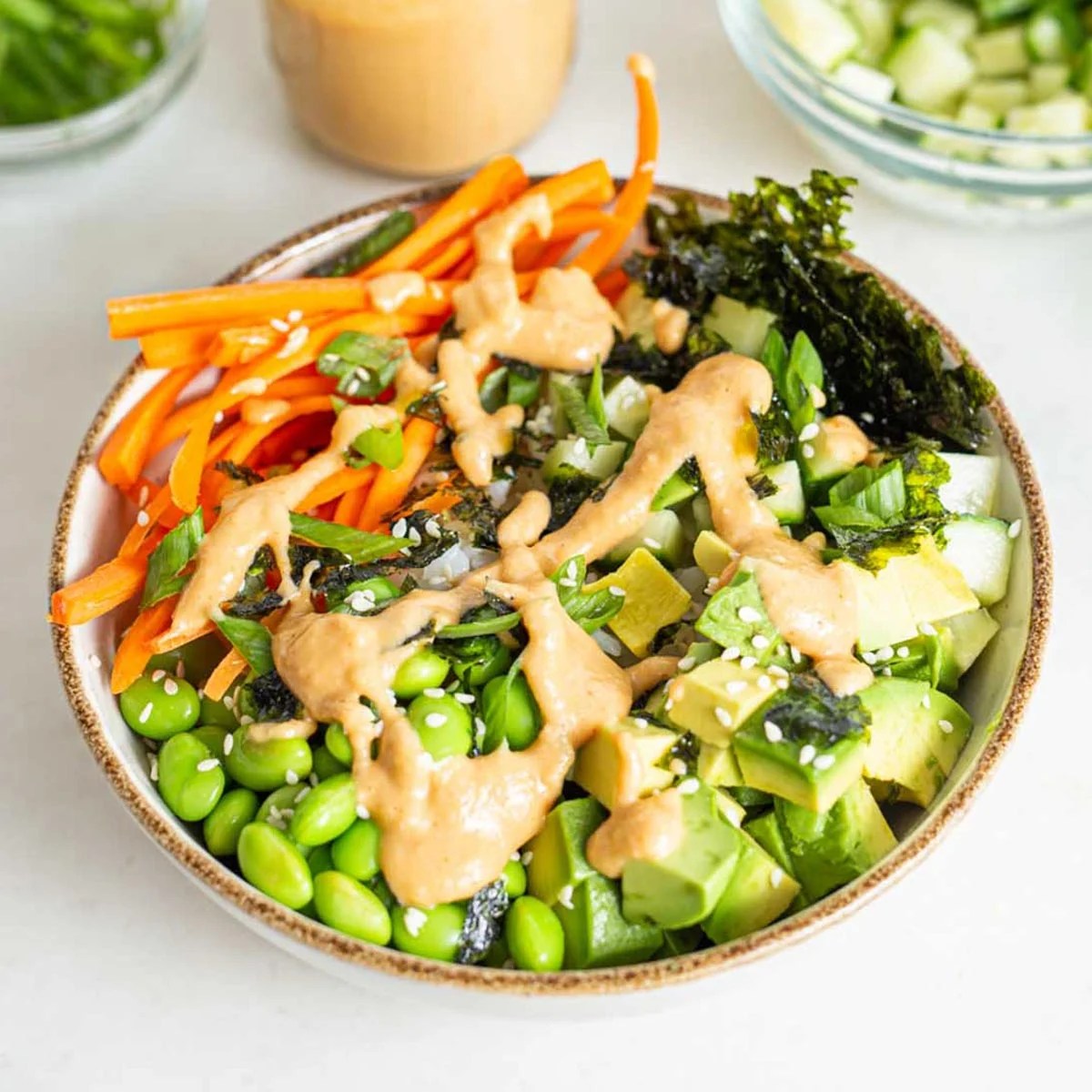Unleash your inner sushi chef with this vibrant guide to crafting delectable vegetarian sushi bowls at home! Forget expensive takeout; this journey will empower you to create stunning, flavorful bowls brimming with fresh ingredients and customizable to your taste. Imagine the satisfying crunch of perfectly prepared vegetables, the soft embrace of sushi rice, and the delightful explosion of savory sauces – all from the comfort of your kitchen.
From selecting the freshest produce to mastering the art of sushi rice preparation and arranging a visually captivating bowl, we’ll navigate every step of the process. Discover the versatility of vegetarian protein options, explore a range of exciting sauces, and learn the secrets to achieving that perfect balance of flavors and textures. Prepare to be amazed by the simplicity and deliciousness of homemade vegetarian sushi bowls.
Ingredient Selection and Preparation
Crafting a stunning and delicious vegetarian sushi bowl begins with thoughtfully selecting and meticulously preparing your ingredients. The vibrant colors and textures of fresh, high-quality components are key to creating a visually appealing and flavorful dish. Careful preparation ensures each element complements the others, resulting in a harmonious and satisfying culinary experience.
Grain Selection and Preparation
The foundation of any sushi bowl is the rice. Sushi rice, with its short grains and sticky texture, is ideal. Rinse the rice thoroughly under cold water until the water runs clear, removing excess starch. This step is crucial for achieving the perfect texture. Then, cook the rice according to package directions, typically with a water-to-rice ratio of 1.25:1. Allow the cooked rice to cool slightly before gently incorporating a rice vinegar mixture (rice vinegar, sugar, and salt) to enhance its flavor and texture. The resulting rice should be subtly sweet and pleasantly tangy, providing a perfect base for the other ingredients.
Vegetable Selection and Preparation
A variety of vegetables adds both visual appeal and nutritional value to your sushi bowl. Consider using vibrant, colorful options such as: avocado (sliced thinly for a creamy texture and rich green hue), carrots (julienned or finely diced for a crisp sweetness), cucumber (thinly sliced or diced for a refreshing crunch), edamame (shelled and steamed for a pop of color and protein), bell peppers (diced into small, colorful pieces), and shredded purple cabbage (for a beautiful contrast and added texture). The key is to maintain a balance of textures and colors. Careful chopping techniques, like the precise julienning of carrots or the delicate slicing of avocado, will elevate the presentation.
Vegetarian Protein Source Selection and Preparation
Several excellent vegetarian protein sources can elevate your sushi bowl. Tofu, pressed to remove excess water, can be pan-fried, baked, or marinated for added flavor and texture. Tempeh, another fermented soybean product, offers a heartier texture and earthy flavor, and works well grilled or pan-fried. Edamame, as mentioned earlier, provides a complete protein and delightful vegetal taste. Consider incorporating roasted chickpeas or edamame for added texture and protein. Pressing tofu is vital; wrap it in a clean kitchen towel and place a heavy object on top for at least 30 minutes to remove excess moisture and create a firmer texture that holds its shape better in the bowl.
Visually Appealing Ingredient Arrangement
Arranging your sushi bowl ingredients thoughtfully enhances its visual appeal. Consider a concentric circle arrangement, starting with the rice in the center and then layering the other ingredients around it in a visually pleasing pattern. Alternatively, you can create distinct sections within the bowl, grouping similar ingredients together. Use contrasting colors and textures to create visual interest. For instance, the bright green of avocado against the deep purple of shredded cabbage makes a striking combination. Sprinkling toasted sesame seeds adds a final touch of visual appeal and subtle nutty flavor.
Nutritional Comparison of Vegetarian Protein Sources
| Protein Source | Calories (per 100g) | Protein (g per 100g) | Fiber (g per 100g) |
|---|---|---|---|
| Tofu | 76 | 8 | 2 |
| Tempeh | 190 | 19 | 8 |
| Edamame (shelled) | 120 | 11 | 5 |
| Chickpeas (cooked) | 164 | 9 | 7.6 |
Vegetarian Protein Options and Sauces
Creating a satisfying and flavorful vegetarian sushi bowl hinges on selecting the right protein and complementing it with a delicious sauce. The options are diverse and offer a range of textures and tastes, allowing for endless customization. This section explores several popular choices, along with simple recipes to elevate their flavor profiles.
Tofu Preparation
Firm or extra-firm tofu works best for sushi bowls, as it holds its shape well after cooking. To prepare, press the tofu to remove excess water; this prevents a soggy bowl. Cube the tofu into bite-sized pieces. You can then pan-fry it until golden brown and crispy on all sides, adding a touch of sesame oil for extra flavor. Alternatively, bake it in the oven at 400°F (200°C) for 20-25 minutes, or until lightly browned and firm. Marinate the tofu beforehand in soy sauce, mirin, and ginger for a deeper, more complex flavor. Imagine the satisfying contrast between the crispy exterior and the soft, subtly sweet interior.
Tempeh Preparation
Tempeh offers a slightly firmer, chewier texture than tofu. Crumble it into small pieces and sauté it in a pan with a little oil until heated through and lightly browned. For extra depth of flavor, try marinating it in a mixture of soy sauce, rice vinegar, and maple syrup before cooking. The marinade will tenderize the tempeh and infuse it with a sweet and savory taste. The final product will have a hearty texture, perfectly complementing the other ingredients in your bowl.
Edamame Preparation
Edamame, or young soybeans, are a naturally delicious and nutritious addition. Simply steam or boil shelled edamame until tender. Lightly salt them for a simple yet effective flavor boost. The vibrant green color adds a visually appealing element to the bowl, while the soft, slightly sweet flavor provides a delightful contrast to the other ingredients. Imagine the satisfying pop as you bite into these tender morsels.
Avocado Preparation
Avocado provides a creamy, rich texture and healthy fats. Simply dice or slice ripe avocados, ensuring they are not overripe to maintain their shape. A squeeze of lime juice prevents browning and enhances the fresh, subtly buttery flavor. The smooth, creamy texture of the avocado contrasts beautifully with the other elements of the sushi bowl, creating a harmonious balance of textures and flavors.
Sauce Recipes
A well-chosen sauce can transform a simple sushi bowl into a culinary masterpiece. Here are three options to consider:
- Soy Sauce-Based Dressing: Combine soy sauce, rice vinegar, sesame oil, and a touch of honey or maple syrup for sweetness. Adjust the ratio to your preference for a salty-sweet balance. This versatile sauce complements almost any protein and vegetable combination.
- Sesame-Ginger Dressing: Whisk together sesame oil, rice vinegar, grated ginger, soy sauce, and a pinch of sugar. The fragrant ginger and nutty sesame oil create a complex and flavorful dressing that adds a sophisticated touch.
- Sriracha Mayo: Mix mayonnaise with sriracha to your preferred level of spiciness. This creamy, spicy sauce adds a bold kick and a satisfying richness to the bowl.
Vegetarian Protein and Sauce Options Summary
- Tofu: Pan-fried or baked, offering a crispy exterior and soft interior. Pairs well with soy sauce-based dressings.
- Tempeh: Crumbled and sautéed, providing a firm, chewy texture. Excellent with sesame-ginger dressing.
- Edamame: Steamed or boiled, offering a tender, slightly sweet flavor. Enhances the visual appeal of the bowl.
- Avocado: Diced or sliced, adding a creamy richness. Its mild flavor complements all the sauces.
- Soy Sauce-Based Dressing: Versatile and adaptable to various taste preferences.
- Sesame-Ginger Dressing: Aromatic and sophisticated, offering a complex flavor profile.
- Sriracha Mayo: Creamy, spicy, and bold, adding a kick to the bowl.
Vegetable Selection and Presentation
Creating a visually stunning vegetarian sushi bowl relies heavily on the careful selection and artful arrangement of vegetables. A vibrant array of colors and textures not only enhances the aesthetic appeal but also adds depth to the overall culinary experience. Think of it as painting a picture with your ingredients, each element contributing to a harmonious and delicious whole.
The key to success lies in choosing vegetables that offer a diverse range of colors, textures, and flavors. This variety provides a captivating visual display and ensures a complex and satisfying taste experience. Consider incorporating both raw and lightly cooked vegetables to add textural contrast, transforming the bowl from a simple meal into a miniature work of art.
Vegetable Choices for Visual Appeal
A well-composed vegetarian sushi bowl boasts a captivating spectrum of colors. Think deep oranges from carrots, the bright green of avocado and cucumber, the fiery red of bell peppers, and the earthy brown of seaweed salad. These colors, when strategically arranged, create an immediate visual impact, enticing the diner to delve into the culinary masterpiece before them. The use of contrasting colors, such as the vibrant purple of red cabbage against the deep green of spinach, creates a striking and memorable presentation.
Techniques for Visually Appealing Arrangements
The arrangement of vegetables significantly impacts the bowl’s overall aesthetic. Avoid simply piling ingredients haphazardly. Instead, consider a thoughtful arrangement that guides the eye and enhances the presentation. One effective technique is to create a layered effect, placing taller vegetables like bell pepper strips around the perimeter and smaller components like edamame in the center. Another approach involves arranging vegetables in a radial pattern, emanating from the center of the bowl. This creates a sense of symmetry and visual balance. Remember that negative space is also important; don’t overcrowd the bowl. Allow some areas to breathe and let the individual elements stand out.
Benefits of Diverse Textures and Colors
The interplay of textures and colors elevates the sushi bowl experience beyond simple sustenance. The crispness of cucumber contrasts beautifully with the soft creaminess of avocado, while the slight crunch of carrots complements the delicate texture of seaweed salad. This variety of textures keeps the eating experience engaging and prevents monotony. Similarly, the vibrant colors stimulate the appetite and enhance the perceived deliciousness of the dish. A bowl with a limited color palette can appear bland, while a rainbow of colors evokes feelings of excitement and anticipation.
Step-by-Step Guide to Vegetable Arrangement
- Base Layer: Start with a bed of sushi rice, spreading it evenly across the bottom of the bowl. This provides a stable foundation for the remaining ingredients.
- Strategic Placement of Larger Vegetables: Arrange larger vegetables, such as sliced bell peppers or avocado, around the perimeter of the bowl. Consider alternating colors for a visually appealing effect. For example, place a red bell pepper slice next to a green one.
- Adding Medium-Sized Vegetables: Next, add medium-sized vegetables like shredded carrots or cucumber ribbons. These can be placed strategically within the gaps created by the larger vegetables, filling in spaces and adding more color and texture.
- Incorporating Smaller Components: Incorporate smaller components such as edamame, sesame seeds, or chopped scallions. These can be scattered across the bowl to add pops of color and texture.
- Final Touches: Consider adding a sprinkle of sesame seeds or a drizzle of a vibrant sauce as a final touch to enhance both the visual appeal and flavor profile. This adds a layer of visual interest and elevates the overall presentation.
Assembling and Serving the Vegetarian Sushi Bowls

Creating a visually appealing and delicious vegetarian sushi bowl is a rewarding culinary experience. The key lies in thoughtful layering and a balanced combination of textures and flavors. This section will guide you through the assembly process, offering tips for achieving a perfect presentation and a harmonious taste profile.
Layering Techniques for Optimal Presentation
The art of assembling a sushi bowl lies in creating a visually stunning and balanced composition. Begin by placing your chosen cooked rice in the bowl, forming a gently mounded base. This provides a stable foundation for the remaining ingredients. Next, arrange your protein options—perhaps vibrant edamame, crispy tofu, or colorful shiitake mushrooms— strategically over the rice. Think about color contrast; a sprinkle of toasted sesame seeds can add visual interest and nutty flavor. Subsequently, add your chosen vegetables. Consider arranging them in a visually pleasing manner, perhaps creating a radial pattern or a colorful gradient. A final flourish of your chosen sauce, drizzled artistically, completes the presentation. Imagine a bowl where the vibrant green of avocado contrasts with the deep orange of carrots, all set against the creamy white rice. This careful arrangement elevates the dish from a simple meal to a work of art.
Flavor Balance in Vegetarian Sushi Bowls
Achieving a balanced flavor profile is crucial for a truly satisfying vegetarian sushi bowl. The interplay of sweet, savory, salty, and tangy elements creates a complex and delightful culinary experience. For example, the sweetness of roasted sweet potatoes can be beautifully balanced by the salty tang of pickled ginger. The earthiness of mushrooms pairs perfectly with the creamy richness of avocado. A drizzle of a vibrant sauce, such as a spicy sriracha mayo or a tangy ponzu dressing, adds another layer of complexity and depth. Experiment with different flavor combinations to find your perfect balance. Consider the interplay of textures as well – crunchy vegetables against creamy avocado and fluffy rice. This multifaceted approach creates a more memorable and delicious dining experience.
Storing Leftover Vegetarian Sushi Bowls
To maintain the freshness and quality of your leftover vegetarian sushi bowls, proper storage is essential. First, allow the bowls to cool completely to room temperature. Then, transfer them to airtight containers. Ensure the rice is not directly exposed to air, as this can lead to dryness and spoilage. Refrigerate the bowls immediately. Ideally, consume the leftovers within 24 hours for optimal flavor and texture. Avoid storing the bowls at room temperature for extended periods. Remember, proper storage will ensure your culinary creation remains delicious and safe to consume.
Vegetarian Sushi Bowl Recipe
This recipe provides a framework; feel free to adjust ingredients based on your preferences and available produce.
Ingredients:
- 1 cup sushi rice
- 1 cup water
- 1 block (14 oz) extra-firm tofu, pressed and cubed
- 1/2 cup edamame, shelled
- 1/2 cup shredded carrots
- 1/2 avocado, thinly sliced
- 1/4 cup pickled ginger
- 2 tablespoons sesame seeds, toasted
- 2 tablespoons soy sauce
- 1 tablespoon rice vinegar
- 1 teaspoon sesame oil
- Sriracha mayonnaise (optional)
Instructions:
- Rinse the sushi rice thoroughly until the water runs clear. Combine rice and water in a saucepan and bring to a boil. Reduce heat to low, cover, and simmer for 15 minutes, or until all water is absorbed.
- While the rice cooks, prepare the tofu. Heat a tablespoon of oil in a pan and sauté the tofu cubes until golden brown and crispy.
- Steam the edamame until tender-crisp. Gently toss the shredded carrots with a little sesame oil.
- Once the rice is cooked, gently fluff it with a fork and season with soy sauce and rice vinegar.
- Assemble the sushi bowls by layering the rice, tofu, edamame, carrots, and avocado in a bowl. Garnish with pickled ginger, toasted sesame seeds, and a drizzle of sriracha mayonnaise (if using).
Creating vegetarian sushi bowls is more than just a recipe; it’s a creative adventure. By following this guide, you’ve unlocked the ability to craft personalized masterpieces, each bowl a testament to your culinary artistry. Experiment with different ingredients, sauces, and presentation styles to discover your signature bowl. The journey of creating these vibrant and healthy meals is as rewarding as the delicious final product itself. So, gather your ingredients, and let your culinary creativity flow!
Detailed FAQs
Can I make the sushi rice ahead of time?
Yes, sushi rice can be made a day ahead. Store it in an airtight container in the refrigerator. Gently reheat it before assembling your bowls.
What are some good substitutes for rice vinegar?
Apple cider vinegar or white wine vinegar can be used as substitutes, but the flavor will be slightly different. Adjust the amount according to your taste preference.
How do I prevent my sushi rice from becoming too sticky?
Ensure you rinse the rice thoroughly and use the correct rice-to-water ratio. Avoid overcooking the rice.
Can I use pre-cooked brown rice?
While you can, brown rice’s texture differs from sushi rice, impacting the overall bowl experience. It’s best to use sushi rice for optimal results.


